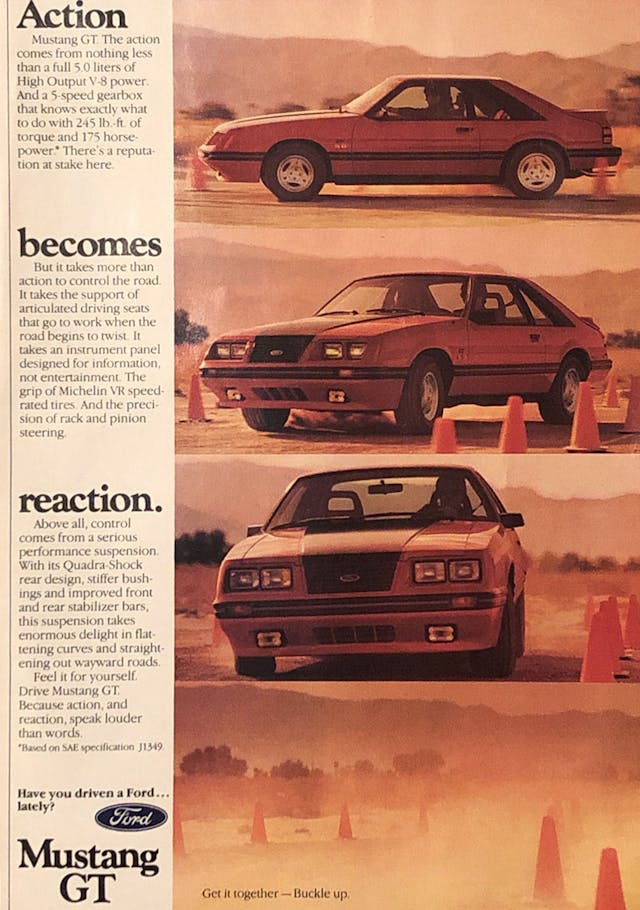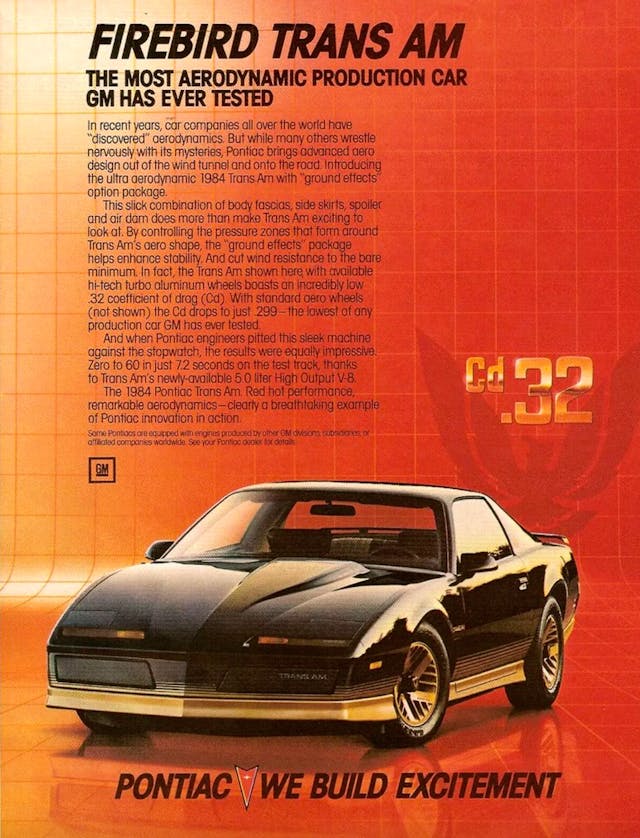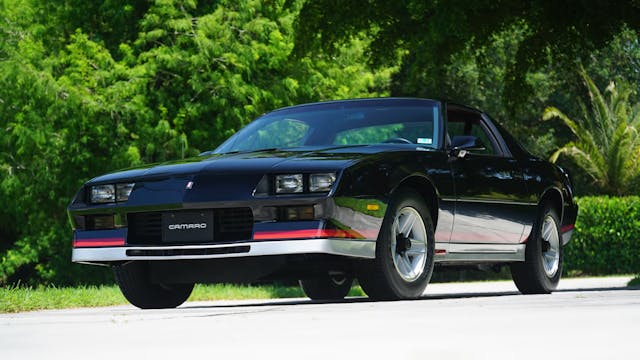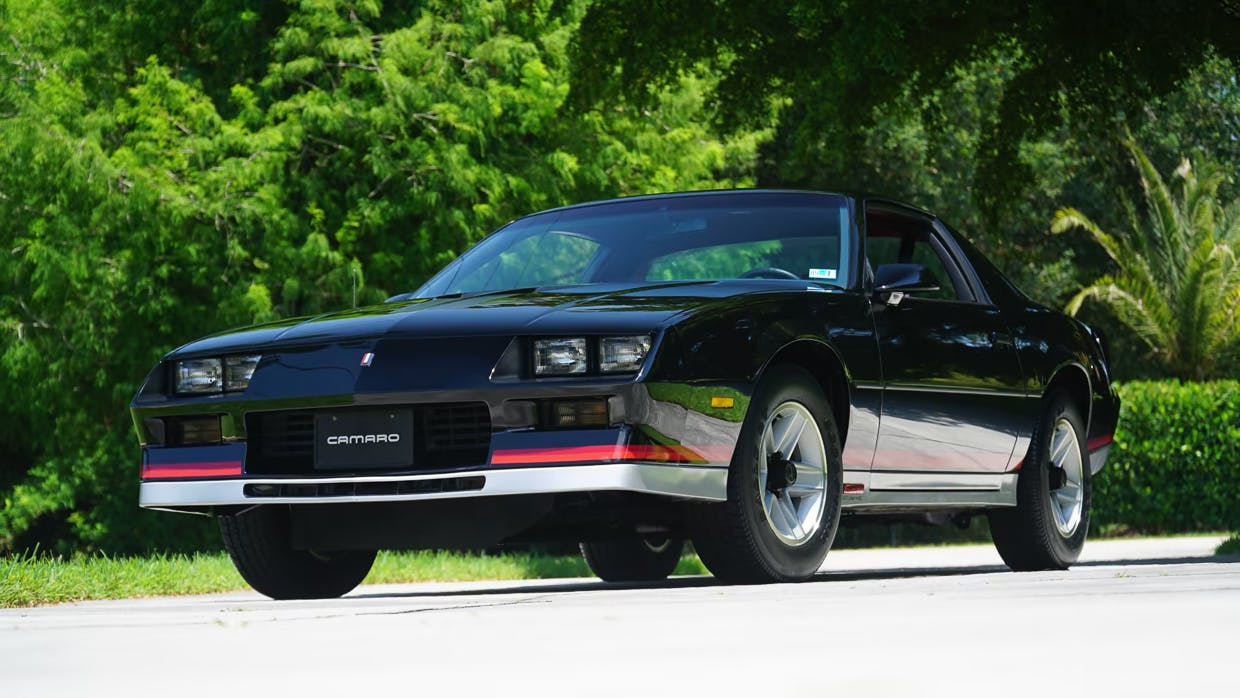Media | Articles
The 40th anniversary of the end of Malaise Era is just around the corner
By most accounts, the term “Malaise Era” was coined by journalist Murilee Martin. Taken from Jimmy Carter’s famous speech, it reflects the pervasive funk that the U.S. found itself in post-Vietnam, though Martin and fellow car enthusiasts tend to further focus it as the term to define a decade’s worth of lackluster autos. The period was marked by rampant inflation and a frustratingly stagnant economy. Everything from American exceptionalism to oil, and even natural fibers, seemed to be on the way out, replaced with polyester leisure suits, disco, and well, seemingly not much else. Most importantly, horsepower took a lengthy holiday as fuel prices and insurance rates went up while speed limits went down.
We’re about to mark a truly happy milestone, however: By my count, 2024 marks the 40th anniversary of the end of this much-maligned era. Four decades on from 1984, maybe, just maybe the cars that helped us get back to horsepower and driving enjoyment can find a more appreciative audience, and we can take a more charitable view of the re-emergence of the American performance car. On the other hand, maybe it’s still too soon.
The onset of the Malaise Era came with shocking speed. In 1972, big blocks were as easy to find as Triceratops in the late Cretaceous period. Just two model years later, they had nearly disappeared. The twin asteroid-like impacts of the 1973 oil embargo and the recession that it triggered quickly made the American performance scene look like a post-apocalyptic wasteland. By the 1974 model year, things looked bleak indeed. Horsepower was down dramatically and rising curb weights from things like mandated diving board five-mph impact bumpers helped further blunt performance. By 1978, things had gotten so bad that the fastest American car was actually a truck. The Dodge Lil’ Red Express pickup was one of the few vehicles you could buy that was capable of a sub-seven second 0–60 time.

The degradations that the era spawned have been well-documented—from the Mustang II to the 305-cubic inch “California” Corvette, and the Iron Duke Camaro. All of these were fodder for the “Rust in Peace” series I did for The New York Times in the early 2000s. Even the once-feared Pontiac Trans Am, one of the few large-displacement cars to survive the big block mass-extinction, was only able to extract a pitiful 200 hp from its massive 455 cubic inches in 1975, mimicking the output of a cheap, loud, “as seen on TV” juicer. If you had the distinct displeasure of living through it, the Malaise Era seemed to last as long as the most recent ice age. Bright spots were few and far between, and often, they weren’t American—the Porsche 930 and the Mercedes-Benz 450SEL 6.9 were fast but crazy expensive, and unless you lived in New York or L.A., you likely never saw one.
Help eventually arrived—fuel injection, three-way catalysts with oxygen sensors, multi-valve cylinder heads, turbochargers, and finally variable valve timing, all did their part to make horsepower a thing again. The Buick Regal Sport Coupe/T-Type brought turbocharging to American showrooms around the same time that the Saab 900 SPG Turbo started making its reputation as a seriously quick car. By 1984 the turbocharged, V-6-powered Regal Grand National was making 200 hp and an astounding 300 lb-ft of torque, figures that had rarely been seen since the early ’70s. (It’s important to remember, too, that 200 hp in 1984 SAE net was probably closer to 250 hp in pre-Malaise SAE gross measurement.)
Marketplace
Buy and sell classics with confidence

By 1984, America’s premier pony cars were becoming de-zombified as well. The Z/28 Camaro of that year made 190 hp, and the 5.0-liter Mustang 175 hp. By the next model year, both had cracked the 200 hp mark. 1984 also introduced the fourth-generation Corvette, a dramatic upheaval from the early ’60s roots of the prior generation. The Malaise era was definitively over, although its last vestige, the reviled 55 mph national speed limit, hung on until it was modified in 1987 and then fully repealed in 1995.

Malaise Era cars have certainly found collectability over the last 10 to 15 years—Urethane-nose, late ’70s/early ’80s second-generation Camaro Z/28s, and Bandit Trans Ams, (so-called “mustache muscle”), certainly have their fans, but then oddly enough, so do the Charlie’s Angels-era Mustang II Cobras. These, however, are mainly novelty/irony/nostalgia buys. I suspect few people are likely to care about them after the generation that came of age during the Smokey and the Bandit and Fast Times at Ridgemont High days passes from the scene.
It’s the cars that brought an end to the era, the turbocharged Regals, IROC-Zs, and post-1983 Fox-body Mustangs, that we should be building bronze statues to, or at the very least, collecting with more gusto. They truly saved driving and ensured that horsepower didn’t become just another quaint unit of measurement (like pennyweights or Macedonian cubits), understood and remembered only by our grandparents and great-grandparents.

***
Check out the Hagerty Media homepage so you don’t miss a single story, or better yet, bookmark it. To get our best stories delivered right to your inbox, subscribe to our newsletters.





The 80’s was the start as Fuel Injection arrived and other things that continued to enhance performance.
But I think what really gets overlooked is this was the era where American cars began to go left and right. Other than the Corvette and the Trans Am or some specialty car like a GT350 most American cars were not handling cars.
Even if they had a handling package too often it was just bigger tires and bigger springs with bigger sway bars. they were stiff hard riding and horrible on real roads. Along the way most forgot about getting the shocks right.
The 84 Corvette Z51 is a prefect example of this. It was tested on the track an in hiding so much they never really got on real roads. The shocks were chosen poorly and you would lose a filling on a Detroit street.
As time went on companies like GM went to Germany to tune their cars and today we have cars that handle as well as any from any country.
The 55 mph speed limit didn’t go away until January 1996. I remember because I got a 70 in a 55 speeding ticket on my way back to college in 1995 from Thanksgiving. A ticket I wouldn’t have gotten 5 weeks later driving back to college from New Years 1996.
Hi JW, I added a bit to clarify. The law was amended when Sass said, and many but not all states took action on it. In 1995 it was repealed completely as you mention, taking effect just a wee bit late for your 70 mph Thanksgiving trip. -EE
I don’t like the “malaise era” term it is too much of a political science looking down on the peasants thing for me. Hagerty is about promoting the hobby, “malaise” doesn’t do that.
-Mustang II was a great sales hit. Auto media has enjoyed taking pot shots at them for decades but to still do so is glossing over the reality that it was a successful car, an important car (street rodder movement built on the suspension and you don’t get a Fox body without the sales case the II made…).
-Many, many personal luxury Brougham era vehicles were a popular success. The colonnade roof style was far nicer to the back seat occupants than this newer trend of “fastback roofs” on CUV and sedans.
Lots of large cars continue to sell, but the “downsizing” GM started to full size vehicles in the late 70s was really just getting back to the norm of pre-58 (and what the good-selling A-bodies through the 60s were).
-Now the land-barges are becoming more sought after again…
Yes the big bumpers were generally ugly. You look at what the designers meant for most of the 72-74 launching models they had minimal bumpers in the renderings. 70s Cutlasses are a standout design even with the bumpers… and 2nd Gen Monte Carlo has lines that are underappreciated. Mid 70s Torino don’t have to be Starsky and Hutch to look good, and is unusual in that the 4-door version has good lines (which 4 doors often compromise).
Yes the Brougham exterior details (opera window, miles of vinyl, fog lights) and colours became suddenly and terrible out of fashion and have never really come back.
Yes the overall performance was way down, but for the average consumer this wasn’t a big deal. We have the opposite now where a grocery-only minivan is faster off the line than vintages Mustangs.
Yes the economy and changing tastes caught the US automakers moving slow. Their best selling sedans were replaced by minivans and import sedans for huge slices of the sales pie… now the market that was US sedans is mostly crew cab pickups and SUVs. I like trucks, but in many respects there is more to have malaise about now.
I worked for a subsidiary of FoMoCo in the ’70’s and very early ’80’s, and I had an executive lease car perk the last five years I worked there. One of my first lease cars was a ’78 Mustang II. It was a wicked looking black fastback with T-tops, little slot mags and RWL tires. The interior was screaming red. We were allowed to select any car with any options in the FoMoCo line every year. I had five different lease cars including two Fox Bodies and a German Capri Snow Cat, but none of them got the kind of eyeball that the Mustang II did. I ordered my MII with the 2.6L V6 because California hadn’t approved the 302 with a 4 speed and I wanted to shift. It was a really fun car in the middle of the Malaise Era. BTW, my selection in ’80 was a bright yellow Mustang GT with a turbocharged 2.3L I4. That was a pretty peppy little car too. Why did I ever quit???
Dude. It is a term that has been used for years that no one has a problem with. Except you. The rest of the world moves along despite you objection to a word. I think you could find far better things to clutch your pearls for than a word that sums up a terrible era in not just cars, but the economy in general. What people collect has nothing to do with a word that describes them. It has everything to do with their interest in it and affordability.
“a term that has been used for years that no one has a problem with. Except you.”
Nonsense. Snailish made a fair point of it being a snobbish term and he isn’t the only one to think so.
Hey Rob Sass, you forgot to mention the role that the EPA and the environmentalist movement had in the demise of the muscle car. It wasn’t gasoline prices as you contend but government interference in the market. All the “car guys” I knew would have bought the big old gas hogs if they were available but D.C. wouldn’t allow it. I had a full sized ’83 Bronco with a 32 gal tank.
I don’t mind the term ” Malaise Era ” and I seriously doubt it’s going to discourage anyone who wants a vehicle from that general time frame from buying one. Much like people calling this car or that a piece of junk , that’s not going to make the guy who’s restoring one fold everything up and put a ‘4 Sale’ sign on the windshield. More likely, they’ll double their effort instead. 1984 seems like a fair point to declare the ending but it is just a way of putting things into neat little categories which we tend to do right or wrong. Much like a painter for example may be put in this school even if their work is in many ways otherwise. So I wouldn’t be all that surprised to find that the cassette player in an 82 Mustang still works and suddenly hear Elvis Costello doing ‘Pump It Up’ . ‘This Years Model’ was released in 78.
and ps -snalish I have a 72 Torino two door ( built in Windsor Nov 71, with the little known _ ” Make these things look like Buicks” – ‘ Knudsen Nose’ that only lasted a few months ) and you’re right it does have great lines…but…. it is a nightmare to back into a garage. Those bulging outward creases come at a cost.
Turbochaging is what helped make most of the memorable cars for me from the 80’s. Msot of the V8’s were blah and did not get interesting till the end of the 80’s. But Turbo Regals, Mustang, Thunderbird, Supra, 300ZX, Starion, RX-7, etc. those cars got my attention.
Some complain about the term “malaise”, which once again proves that too many in this country (and probably the world) take personal offense where none was intended. Until someone comes up with a better descriptor for the 1970’s, “malaise” works well for me – and I own two 1970’s big cars.
1984 to me was the rebirth of performance, I had ’78 & ’80 Corvettes and with addition of a comp cam, power was improved. The Monte SS and ’84 Camaro with a couple of illegal mods could finally beat my buddy’s stock turbo mustang.
The shining light was the ’84 Grand National. The joy in finally getting something with some hint of power and also easy mods to make it even faster, not to mention “We Brake for Vettes” The fastest american car from ’84 to ’87 sure ticked off a lot of vette drivers.
I had the privilege of owning 4 of these thru the years and still have a ’85 turbo riviera (1 of approx 3400 rivi’s).
Very fun cars
The best one was the ’89 turbo Trans Am.
Too bad the run was limited and priced out of the average person’s budget. It had it all, performance and handling.
Being a teen in the 80’s, I certainly appreciated these times. My friends and I couldn’t wait for the next Car and Driver or Motor Trend to come out to justify whomever’s argument on whether the Trans Am or Mustang GT was faster. They got better every year. I will say though, that 1982 is more of a target year for the end of the Malaise. That year’s Mustang GT was the flame that rekindled the pony car wars along with the improved Thirdgen F bodies. Also, the 83 and 84 GT had the same output. Great times indeed…actually more fun than now..even with less horsepower.
My wife and I bought our first new car in 1984. A 20th Anniversary Mustang GT 5.0, 5 speed, hatchback. Worked on it changed things, participated in 2 traveled cross country moves, hauled ladders, wood, garden equipment, cement bags, you name it. Drove our son to his first day of school. Drag raced it, modified it, with a 75 shot of NOS got it in the 12’s in 1/4 on street tires. Won numerous bracket races with it and overall has been a great car. And after over 200,000 miles still have it, and that same wife too. So many memories. It is like your favorite pair of jeans, ripped. faded, but fits just right.
The crash-resistant bumpers mandated in 1973 were a breaking point for the editors at Road & Track magazine. They actually published an article recommending its readers avoid buying any new vehicle that year. Pretty bold decision given that their bread and butter came from the auto industry.
This is also the 16th anniversary of the birth of the term Malaise Era, a contrivance by journalist Phil Gredon. I was active during the alleged period and the term certainly didn’t exist in the seventies and eighties.
Government interference helped the Malaise Era manufacturers by bringing about the 1981-1984 JPN Auto Import Quotas that restricted the number of imported cars to the U.S. Washington made it possible for the Big 3 to raise prices and corresponding profits without fear of losing market share to less expensive competitors. The public chose better quality and economics regardless of the quotas. I hope that lessons have been learned by all of those involved.